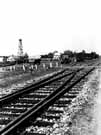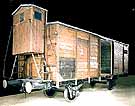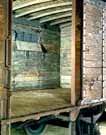
|
|
|

|

|

|

|
|
Click on an image to see a larger, more detailed picture.
|
|
|
|
|
| 1943: Death and Resistance |

|
pg. 415 |

|
|
|
|
| |
 Reichsbahn
Reichsbahn
Fahrplananordnung 586 was a train schedule that was dated August 25, 1942. During the Holocaust, thousands of these German documents coordinated railroad traffic to Nazi killing centers in Occupied Poland. Scheduled to leave Luków, Poland, at 10:44 a.m. on August 28, Fahrplananordnung 586's "Resettlement Special Train" pulled 25 freight cars. Its scheduled arrival time at the Treblinka death camp was 2:52 p.m. The empty train left Treblinka at 5:22 p.m. By then, 2500 Jews--the train's cargo--had been gassed. This transport was not the largest to reach Treblinka. The Reichsbahn, the German railroad network, played an essential part in the "Final Solution." Working with Adolf Eichmann and the SS, Reichsbahn officials organized the Sonderzüge (special trains) that sent Jews from all over Europe to their deaths at Belzec, Chelmno, Sobibór, Majdanek, Treblinka, and Auschwitz-Birkenau. Even amid the war's demands and shortages, these trains had high priority. They usually reached their destinations as scheduled. Herded like cattle into freight cars--with 80 to 100 or more persons packed into a single wagon--the Jews were still ticketed as passengers on miserable journeys that could last for days. The SS used money and property seized from Jews to pay for fares--one-way.
Photo: Bildarchiv Preussischer Kulturbesitz
|

Photo: United States Holocaust Memorial Museum Photo Archive 1989.225.1
|
 Millions of Jews were deported to their deaths in cattle cars such as this (right and below). Up to 100 human beings were crammed into spaces that measured 31'6" x 14' x 13'2". The journey to a concentration camp was an unimaginably terrifying experience. Once the doors were sealed, the occupants were deprived of water and proper sanitation facilities. Thousands of people died en route and others went insane. On more than one occasion, parents and children engaged in lethal struggles for a crust of bread or a drink of water. The terror and disorientation were heightened by the fact that the Jews had no notion of where they were going.
Millions of Jews were deported to their deaths in cattle cars such as this (right and below). Up to 100 human beings were crammed into spaces that measured 31'6" x 14' x 13'2". The journey to a concentration camp was an unimaginably terrifying experience. Once the doors were sealed, the occupants were deprived of water and proper sanitation facilities. Thousands of people died en route and others went insane. On more than one occasion, parents and children engaged in lethal struggles for a crust of bread or a drink of water. The terror and disorientation were heightened by the fact that the Jews had no notion of where they were going.
Photo: United States Holocaust Memorial Museum Photo Archive 1989.225.1
|
|

|

|

|

|
 January 14-24, 1943: British Prime Minister Winston Churchill and United States President Franklin Roosevelt meet at Casablanca, Morocco, to discuss the future Allied invasion of Western Europe. News of the meeting buoys the spirits of Jews, who hope the war may soon be over. Roosevelt, though, proposes to French North African official General Noguès and later to a leader of the Free French Forces, General Giraud, that the French government in North Africa should discriminate against local Jews just as Hitler did in the 1930s. Roosevelt specifically states, twice--once to Noguès and separately to Giraud--that "the number of Jews engaged in the practice of the professions...should be definitely limited to the percentage that the Jewish population in North Africa bears to the whole of the North African population." President Roosevelt adds that limiting the number of Jews in the professions "would further eliminate the specific and understandable complaints which the Germans bore toward the Jews in Germany...."
January 14-24, 1943: British Prime Minister Winston Churchill and United States President Franklin Roosevelt meet at Casablanca, Morocco, to discuss the future Allied invasion of Western Europe. News of the meeting buoys the spirits of Jews, who hope the war may soon be over. Roosevelt, though, proposes to French North African official General Noguès and later to a leader of the Free French Forces, General Giraud, that the French government in North Africa should discriminate against local Jews just as Hitler did in the 1930s. Roosevelt specifically states, twice--once to Noguès and separately to Giraud--that "the number of Jews engaged in the practice of the professions...should be definitely limited to the percentage that the Jewish population in North Africa bears to the whole of the North African population." President Roosevelt adds that limiting the number of Jews in the professions "would further eliminate the specific and understandable complaints which the Germans bore toward the Jews in Germany...."
|
 January 14, 1943: When the Jewish Council and Jewish police in Lomza, Poland, refuse to provide the Gestapo with 40 Jews, Gestapo agents make the selections, and include two Council members. A further 8000 Lomza Jews are deported to Auschwitz.
January 14, 1943: When the Jewish Council and Jewish police in Lomza, Poland, refuse to provide the Gestapo with 40 Jews, Gestapo agents make the selections, and include two Council members. A further 8000 Lomza Jews are deported to Auschwitz.
|
|
|
|
|
| 1943: Death and Resistance |

|
pg. 415 |

|
|
The Holocaust Chronicle
© 2009 Publications International, Ltd.
|
|
